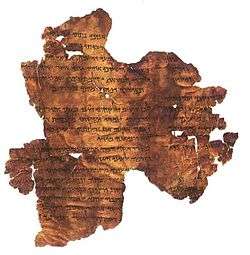4Q166
4Q166 (or 4QpHosa; Hosea Commentary; Pesher Hoshe`a), also known as The Hosea Commentary Scroll, is one of the Dead Sea Scrolls and was found in Cave 4 at Qumran in the West Bank. The parchment of 4Q166, 17.5 cm (6 7/8 in.) by 16.8 cm (6 5/8 in.) in size, is estimated from late first century B.C.E.[1] The manuscript is the larger of two unrelated fragments of the Hosea Commentary found in Cave 4. The script, which is identical to that of a commentary on Psalms, belongs to the rustic, semiformal type of the Herodian era.[2]

Contents
This text is a commentary, or "pesher," on the prophetic biblical verses from the book of Hosea (Hosea 2:8-14). The verse presented here refers to the relation of God, the husband, to Israel, the unfaithful wife. In the commentary, the unfaithful ones have been led astray by "the man of the lie." The document states that the affliction befalling those led astray is famine. Although this famine could be a metaphor, it may well be a reference to an actual drought cited in historical sources of that time.[2]
Publication
The Hosea Commentary Scroll was first published by J. Allegro as the fifth volume of the official publication series, "Discoveries in the Judaean Desert."[3]
In 1979, M. Horgan completed a work on all the "pesharim," or commentaries, which included an extensive treatment of the Hosea Commentary fragments. The "pesharim" interpreted the biblical text in light of events of the late Second Temple Period—seeing within the text prophesies and messages relevant to the community's beliefs and practices.[4]
See also
- Book of Hosea: chapter 2
- Tanakh at Qumran
References
- Courtesy of the Israel Antiquities Authority
- Hosea Commentary. Pesher Hoshe`a. Deadsea Scrolls Exhibit
- John Marco Allegro. Qumran Cave 4. DJD V (Oxford, 1968) Printed book. General Collections, Library of Congress.
- Maurya Horgan. Pesharim: Qumran Interpretations of Biblical Books (Washington, D.C., 1979) Printed book. General Collections, Library of Congress